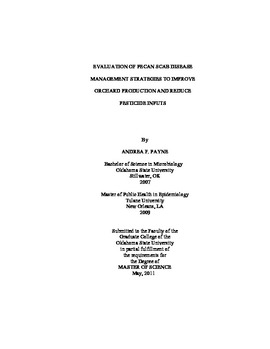| dc.contributor.advisor | Smith, Damon L. | |
| dc.contributor.author | Payne, Andrea F. | |
| dc.date.accessioned | 2014-04-15T21:16:51Z | |
| dc.date.available | 2014-04-15T21:16:51Z | |
| dc.date.issued | 2011-05-01 | |
| dc.identifier.uri | https://hdl.handle.net/11244/9007 | |
| dc.description.abstract | To facilitate the subsequent studies, initial experiments evaluated growth media best suited for maximizing sporulation of F. effusum in vitro . Additional studies were aimed at improving our understanding of weather conditions that are favorable for pecan scab epidemic initiation and progression in Oklahoma. In addition, influential relative humidity and temperature thresholds in pecan orchards were reevaluated for use in models to predict epidemics of pecan scab. Other biologically significant weather variables were also evaluated for inclusion in an updated advisory. Finally, experiments were conducted to understand the influence of early fungicide treatments in Oklahoma pecan orchards. Potato dextrose agar was found to be the best medium for the growth and sporulation of F. effusum . Malt extract agar and potato carrot agar amended with 50% lactic acid were also favorable for the growth and sporulation of F. effusum in vitro . The disease prediction model developed during this study was adjusted for the effects of solar radiation and the accumulation of rain in a dynamic fashion. By doing so, it was evident that the thresholds used by the current advisory closely estimated periods of scab increase, but accuracy might be improved by adding the effects of solar radiation and rain. Furthermore, a new model using dew point and dew point depression was developed. Further validation studies using these models should be performed to identify any improvement in the ability to predict fungicide application. Data from field trials suggest that in Oklahoma growers can use an abbreviated fungicide program, which provides scab control during the early stages of the season and can be relaxed during months of July and August. Considering the increased susceptibility of pecans to damage by pecan scab during early stages of development, this study has demonstrated that fungicide protection be used when conditions are favorable for disease during the early growing season. | |
| dc.format | application/pdf | |
| dc.language | en_US | |
| dc.publisher | Oklahoma State University | |
| dc.rights | Copyright is held by the author who has granted the Oklahoma State University Library the non-exclusive right to share this material in its institutional repository. Contact Digital Library Services at lib-dls@okstate.edu or 405-744-9161 for the permission policy on the use, reproduction or distribution of this material. | |
| dc.title | Evaluation of Pecan Scab Disease Management Strategies to Improve Orchard Production and Reduce Pesticide Inputs | |
| dc.type | text | |
| dc.contributor.committeeMember | Damicone, John | |
| dc.contributor.committeeMember | Smith, Michael | |
| osu.filename | Payne_okstate_0664M_11420.pdf | |
| osu.college | Agricultural Sciences and Natural Resources | |
| osu.accesstype | Open Access | |
| dc.description.department | Department of Entomology and Plant Pathology | |
| dc.type.genre | Thesis | |
| dc.subject.keywords | carya illinoinensis | |
| dc.subject.keywords | cladosporium caryigenum | |
| dc.subject.keywords | disease advisory | |
| dc.subject.keywords | fusicladium effusum | |
| dc.subject.keywords | pecan | |
| dc.subject.keywords | pecan scab | |
